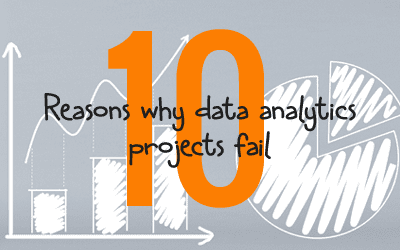Thinking of investing in data analytics? Successful data analytics projects are the holy grail of businesses globally for the actionable insights they provide. However, year after year companies pour thousands of dollars and hours of effort into data analytics projects that fail miserably.
Why is this?
Here are the top 10 reasons why data analytics projects fail:
Dirty, inconsistent data
Data needs to be high quality and accurate for fueling effective insights. When the basic data is flawed, how good are the analytics going to be? Data may be missing or incorrect – this can throw a spanner in the works of achieving actionable insights. You need to make sure the data you work with is clean, current and complete.
Your data is Rapunzel locked in her tower
Enterprises that have been around for any length of time may have tens of hundreds of internal databases. Data may be siloed in legacy databases that cannot share their data due to their inherent complexity. Businesses often think they can pipe the data into a data warehouse for sharing across the enterprise, but this can be prohibitively expensive and delays in deriving value from data are costly and frustrating.
Lack of a single, trustworthy foundation
Owing to the lack of a single data platform, many businesses find it overwhelmingly difficult to access their own data. When analysts have to access data, the problem is compounded further. True story: a client of ours, was taking up to 2 weeks to access data. Old legacy databases, firewalls etc. were slowing down the process so much so that analysts were digging out data from reports. For reliable output, it is optimal to have a single trustworthy foundation, built on raw data with transparent transformations. The happy ending to the story is that we fixed the issue for this customer and they were able to access their data in just a couple of hours.
Technical design pattern flaws
Design patterns for accessing data need to be matched to the use case. Very often due to lack of technical expertise, companies end up using the wrong design or implementing a pattern that cannot cope with the huge volumes of data.
The Big Bang approach doesn’t work
Too many businesses like to tackle their data solutions by going in with all guns blazing. They splash out on the latest in the data universe which would probably be overkill at the start, since processes, best practices etc. are nascent. Following an Agile methodology is a prudent and economical approach – start small and then scale up as your needs evolve.
Ignoring future performance
The initial design should have future performance built in. Keep in mind that data will grow enormously every year and the solution should be able to handle escalating loads with ease without any strain on source systems. Think, plan and design for the future now.
Trying to build a data integration solution instead of investing in an automated data integration tool
Building instead of buying is one of the worst mistakes in the book. The development team will hand code the data integration solution keeping in mind the current requirements of the business. Unfortunately, when it comes to data, requirements often change, and the solution simply will not be able to handle the new evolving data needs and increasing volumes of queries. Also, the DIY approach takes months to code and put in place where an automated tool could actually do it all efficiently in a matter of hours. Automated tools have been around for a while, they are designed to scale up and work in all kinds of scenarios –is it really necessary to reinvent the wheel?
Using on-premise data integration tools for a cloud-based solution and vice versa
This is the equivalent of filling petrol in a car that runs on diesel and expecting it to work. On-premise data integration tools are not usually appropriate for cloud solutions and vice versa. It is almost always a struggle to get the right fit for a seamless, efficient performance. Stick to the right tools!
Collaboration and education are non-existent
Getting buy-in from all stakeholders and collaborative working is important for production of data insights. Companies often hire highly qualified data experts who are not really integrated into the company’s work culture. Also, people who need to use the data may need further training or could be too busy or disengaged to use the data analytics solution at all.
Treating the data analytics project as just another IT project
Companies need to view data analytics projects from a long-term perspective instead of thinking of them as IT projects. Data analytics systems should be set up with a roadmap –how the data will be used, architecture, infrastructure scalability for future needs, suitability for the organization’s operations and goals etc. Long term planning will pay off rather than a knee jerk reaction of ‘All the cool kids are doing it; let’s get ourselves a data project!’
Alert-shameless plugin coming up: Say hello to BryteFlow!
If you wish to sidestep most of the problems we mentioned before, BryteFlow is what you need for real-time data integration to S3, Redshift and Snowflake. Your data is verified constantly for completeness and you can actually deploy data in hours instead of months.
Ask us for a demo now.
There is also a FREE Trial available on AWS Marketplace. We are the first and only AWS Partner with Big Data Competency in the APAC region and were recognized as AWS Partner of the Year 2018.





